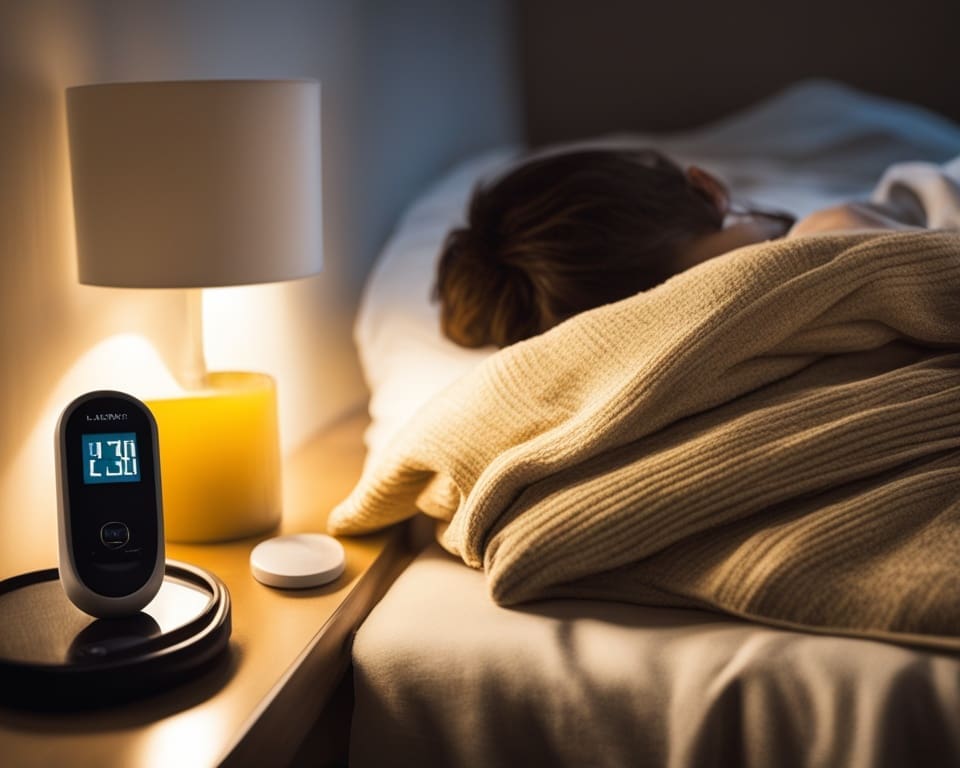Stress can make it hard to manage your diabetes. When you’re under stress, you might forget meals or medications. This can change your blood sugar levels. It’s essential to learn how to deal with stress to keep your diabetes in check.
It gives you the energy to eat well, do physical activities, monitor your blood sugar, and sleep better.1 58% of people with diabetes often feel stressed. This stress can make it tough to handle the condition.
Key Takeaways
- Stress can negatively affect diabetes management by causing missed meals or forgotten medication.
- Effectively managing stress helps control blood sugar levels and supports healthy habits.
- 58% of individuals with diabetes report regular stress, impacting disease management.
- 32% may skip meals or forget medication under stress, leading to blood sugar fluctuations.
- Relaxation techniques like exercise, deep breathing, and music therapy can reduce stress levels.
The Impact of Stress on Blood Sugar Levels
If you have diabetes, stress can impact how well you handle the condition. It starts a cycle where high stress levels make blood sugar rise more.2 When you’re stressed, your body releases hormones like cortisol and adrenaline. These make it tough for insulin to work right.2 Without insulin working well, your blood sugar could go up.2
Stress and Diabetes: A Vicious Cycle
Long-term stress can keep your blood sugar high. This raises the chances of diabetes problems.2 Studies show a big link between a lot of stress and getting type 2 diabetes.2 And if you eat too much or not well to deal with stress, you might gain weight. This can make your chances of getting type 2 diabetes even higher.2
Physiological Effects of Stress on Blood Glucose
Stress can also lead to diabetes distress. This is when you feel like you can’t handle looking after your health anymore. It can lead to burnout.2 Certain stress hormones help your body keep glucose levels and metabolism in check. But they can also cause insulin resistance.3 Elements like free fatty acids and specific receptors can also cause problems with insulin and glucose in type 2 diabetes.3
It’s key to manage stress well to keep your blood sugar and mood in check.2 Take care of yourself by sleeping enough, exercising, and not using bad stress coping methods. This will help you deal with stress and keep your glucose levels steady.2 Also, using stress management, learning about diabetes, and talking with people who also have diabetes is a good support.2
To sum up, stress can mess with how you manage diabetes by affecting insulin, causing insulin resistance, and leading to unhealthy habits to cope. It’s crucial to break this cycle with good stress management. This way, you can keep your blood sugar in check and avoid diabetes complications.
Identifying and Challenging Negative Thought Patterns
When dealing with diabetes, our thoughts matter a lot. Having negative patterns can lead to more stress. This stress can make it hard to keep our glucose in check and manage our diabetes well.
Recognizing Catastrophic Thinking
One type of negative thinking is catastrophic thinking. It’s when we always think of the worst outcomes. For example, if our blood sugar is high, we might say to ourselves, “I can’t reverse diabetes or lower my a1c.” But, it’s important to know that these thoughts are just our minds jumping to the worst and not the truth.
Shifting Focus to the Present Moment
Turning away from catastrophic thinking involves focusing on now. Saying, “I’m safe right now. No harm is here.” This helps us let go of unnecessary worries. Instead, we can work on our breath and ways to relax. This approach aids in managing insulin resistance and keeps our glucose levels in check better.
Fighting negative thoughts and focusing on the here and now is key to reducing blood sugar. It also helps us manage diabetes better overall. Doing so means catching and challenging our irrational thoughts. Plus, using techniques like mindfulness. These steps lead to a brighter outlook and making changes that promote our health and happiness.
Dwelling on worst-case scenarios or “catastrophic thinking” is common during stress but rarely reflects reality.4 Self-management practices for T2DM remain challenging, with approximately 60% of individuals struggling with self-management and glycaemic control.4 Cognitive behaviour therapy (CBT) interventions concerning T2DM self-management aim to raise awareness of how automatic negative thoughts impact self-management practices and how to modify thought and behavior patterns to enhance self-efficacy.4
Breathing Exercises for Stress Relief
When dealing with the burdens of diabetes management, simple breathing exercises prove invaluable. They help keep calm and lower blood sugar. Often, people breathe lightly, which may add to anxiety and deplete energy5. By taking slow, deep breaths, you activate your body’s natural calming response. This can help reverse diabetes.
Deep Belly Breathing Technique
Try the deep belly breathing technique. Sit comfortably and put a hand on your stomach. Inhale slowly through the nose. Feel your belly fill with air. Then, exhale completely. Push the air out and tighten your stomach muscles. Repeat this for a few minutes. Focus on how the breath feels going in and out.
Timed Breathing for Relaxation
There’s also timed breathing. Here, you set a pace for how you breathe in and out. A common way is to breathe in for four counts, hold for seven, and breathe out for eight. Doing this for more than 10 minutes can greatly help manage stress and even improve glucose control. As you keep at it, your lung capacity might increase too5.
Make breathing exercises a part of your daily life, maybe in the morning or before sleep. They bring a peaceful feeling. This can help with managing stress, keeping blood sugar at good levels, and feeling better overall while working to reverse diabetes.
Developing a Calming Mantra
A meaningful phrase or mantra can be your secret weapon against stress. This is especially true for diabetes management moments. When worried about high blood sugar, say to yourself, “It’s just a number.”6 This simple saying redirects your mind from worry to the hard work you’re doing to take care of yourself. Instead of feeling bad, you focus on what you can control to reverse diabetes.
Creating a calming mantra is like a mini-meditation. It helps you relax by concentrating your mind and shutting out distractions. With your own personal mantra, you stay grounded, not carried away by stress. For those dealing with ongoing health issues like diabetes, this can boost your confidence and lend a sense of calm. It offers practical ways to improve your health.6
Mantras stop negative self-talk from taking over. Often, this type of thinking makes health issues worse. Instead of focusing on what’s not right, say something encouraging to yourself. For instance, “I’m trying my best to take care of myself.”7 Using a centering mantra triggers the body’s relaxation response. It can help balance hormones, lower inflammation, and improve insulin homeostasis.7
Different types of meditation, including mindfulness, transcendental, and moving meditation, offer unique benefits for diabetes management.7
Choose a mantra that really speaks to you. Select empowering words if you’re aiming to lower a1c. Here are a few examples:
- “I have the strength to overcome this challenge”
- “My body is capable of healing”
- “I am committed to my health and wellbeing”
The trick is to find a mantra that flips negative thoughts around. With daily use, your calming mantra can become a powerful habit. It helps you through the good and tough times of diabetes.
Visualization and Guided Imagery
When you’re under stress, a good way to manage diabetes and lower blood sugar is through visualization and guided imagery.7 Just close your eyes and picture a peaceful, happy place. This can help you feel calm and relaxed, fighting the effects of stress.
Creating Your Happy Place
Think of a calm spot that makes you happy, like a quiet beach or a green forest.7 This place in your mind is your “happy place.” It’s where you can go to get away from daily stress and relax.
Engaging All Five Senses
When you imagine your happy place, use all your senses.7 Listen for the waves on the shore or the birds singing. Smell the ocean air or the fresh forest. Feel the sun or the breeze on your skin. See the clear water or the colorful plants. Using all your senses makes the experience more real and relaxing.
Adding this visualization to your diabetes care plan can bring you peace. It can help with lowering blood sugar and improving how your glucose is controlled.7 This technique is great for managing stress. It also makes it easier to handle the changes in your diet and lifestyle that diabetes needs.
The Power of Physical Activity
Getting active daily is key to fighting back against diabetes. It helps lower blood sugar and keeps your glucose control in check. The American Diabetes Association supports this with a consensus statement. It shows how exercise is great for type 2 diabetes.8
Aerobic Exercise for Mood Boosting
Just 15 minutes of activities like brisk walks or bike rides help a lot. They release feel-good chemicals, making you feel better.8 This not only brings down stress but also helps you pick healthier habits. These support diabetes management.
Incorporating Movement Breaks Throughout the Day
Taking time for short activities between your day boosts glucose control. Try to move every half hour, like stretching your legs or arms, or a quick walk.8

Research keeps showing how exercise is amazing for diabetes. It helps with glycemic control, blood lipids, and even mortality rates in individuals with diabetes.8
You can do different types of exercises. Try high-intensity intervals, weights, or aerobics. Start moving to beat diabetes and get healthy again.
Meditation and Mindfulness Practices
Adding meditation and mindfulness to your daily life can really help with stress. It improves diabetes management too. Meditation lets you keep a clear mind, so you handle stress better. This can stop stress from affecting your blood sugar and insulin resistance in a bad way.
Getting Started with Meditation Apps
Are you just starting with meditation? Then, a good idea is to try a meditation app on your phone. These apps have guided sessions that teach different techniques. They’re easy to use and can help you meditate regularly. This can lead to better diabetes control over time.
Mindfulness Exercises for Daily Life
Besides sitting down to meditate, you can be mindful during your day. Mindfulness means being in the moment and aware of your thoughts. You can try simple things like focusing on your breath or truly enjoying your meals. These activities can keep stress down and might even help with reversing diabetes over time.
Studies show that meditation and mindfulness are really good for people with diabetes. For instance, a small study found that stress reduction through mindfulness helps control blood sugar in type 2 diabetes.9 There have been trials showing that these techniques lessen stress in the long term and help with managing diabetes well.
There’s also evidence that being mindful improves physical and emotional health in diabetes patients. Still, more research is needed to fully understand these benefits.
For those with type 1 diabetes, mindfulness may help in making better health choices and lowering A1C levels.11 And there’s evidence that mindfulness can cut down anxiety, depression, and aging effects. It can even help you sleep better.11If you make meditation and mindfulness regular parts of your day, you might feel more steady and strong. This can be a great help in managing diabetes. It might even lead to less severe diabetes and a healthier life overall.
Cultivating an Attitude of Gratitude
In managing diabetes, gratitude matters. It helps lower stress and blood sugar levels. Studies found that being grateful improves physical health and sleep. It may also help control blood glucose in those with diabetes.12
Keeping a Gratitude Journal
Keeping a gratitude journal is simple and powerful. Daily, write about the good parts of your life. This could be enjoying meals with friends, getting hugs, or reading alone.12 Less gratitude in diabetics links with lower HbA1c and slightly worse life quality.12
Savoring Life’s Simple Pleasures
Don’t stop at just journaling. Take time to enjoy simple things. These moments can lower stress and help with insulin resistance. Enjoy the sun on your face, the smell of coffee, or laughter with friends.12 Studies show that thankful people are more likely to do good for their health. This attitude can boost their mental and physical health12.
Gratitude unlocks the fullness of life. It turns what we have into enough, and more. It turns denial into acceptance, chaos into order, confusion into clarity…It makes sense of our past, brings peace for today, and creates a vision for tomorrow. – Melody Beattie
Gratitude spins a cycle of positivity in diabetes management. It eases stress and aids in maintaining lower blood sugar. This approach benefits both physical and emotional health in your diabetes management.
Embracing Conscious Choices
Managing diabetes well means making smart choices without feeling guilty.13 You are in control. Sometimes, it’s okay to enjoy treats like cake at a party. You can adjust your insulin or exercise to keep your blood sugar right.

Overcoming Guilt and Shame
Guilt and shame about food are tough issues for those with diabetes. These feelings don’t help and can make things worse. Be kind to yourself. Remember, it’s okay to treat yourself sometimes13. Letting go of guilt helps you focus on what’s good for you.
Making Room for Indulgences
A “diabetic diet” doesn’t fit everyone13. It’s better to find a plan that suits you, considering what you like and need. Such an approach lets you enjoy treats while you stay healthy. Just remember, it’s all about moderating your choices.
Use the plate method to plan your meals13. Fill half your plate with veggies, add some protein, and then some good carbs. This way, you get all the nutrition you need and keep your portions in check. Apps can also help you track what you eat and how it affects your blood sugar and activity levels13.
| Myth | Reality |
|---|---|
| Sugar is the devil | Enjoying treats in moderation is possible and important for balance, especially for managing blood sugar13 |
| Carbs are the enemy | Not all carbs are bad. Choosing the right ones in the right portion helps to keep meals healthy13 |
| There is a “diabetic diet” | Focusing on what works for you, like your activity level and favorite foods, is more beneficial13 |
By making informed choices, handling feelings of guilt, and allowing treats in a healthful way, you can better control your diabetes. The key is to face this challenge with a positive, self-determined attitude. This way, you look after your body and your mind together.
Establishing a Bedtime Routine
Creating a calm bedtime routine is key for managing diabetes. It also helps in lowering blood sugar levels. A steady routine regulates your body clock. This leads to better glucose control, night and day.1415
The Benefits of a Warm Bath
Before bedtime, a warm bath is a great way to relax. A ten-minute soak can make you sleep quicker. It also relaxes your muscles and makes you feel calm. This gets your body ready for sleeping, which is good for blood sugar control.
Winding Down with Relaxation Techniques
Along with a bath, add other relaxation to your night. Try muscle relaxation, deep breaths, meditation, or picturing peaceful scenes. These activities relax your mind and body. They lower stress, which helps keep your blood sugar stable.1415 Doing these before sleep sets the stage for good rest. Sound sleep is vital for keeping your insulin in check and managing blood sugar well.15
| Relaxation Technique | Benefits |
|---|---|
| Deep breathing | Lowers blood pressure, reduces stress hormones, and improves insulin sensitivity. |
| Meditation | Promotes mindfulness, reduces cortisol levels, and enhances overall well-being. |
| Visualization | Engages the mind in a calming imagery, shifting focus away from worries and promoting relaxation. |
A consistent bedtime routine with relaxation helps you sleep better. It also manages your blood sugar and improves diabetes care.141516
Reverse Diabetes Through Stress Management
Being proactive in handling stress with activities like gratitude and making mindful choices starts a positive cycle. This cycle helps in lowering blood sugar levels. It also aids in reversing diabetes progression.3
Lowering Blood Sugar with Mindful Living
Practicing mindfulness with deep breaths, visualizing, and grounding can help. It lets you manage insulin resistance and keeps glucose control in check.3 Living mindfully helps you stay in the now, lessening the stress effects on your body. This, in turn, boosts diabetes management.
Preventing Diabetes Complications
Mastering stress management lets you stick to good habits that are key in preventing diabetes complications. When stress is under control, making smart choices about diet, exercises, and medicine is easier. These choices are vital for your health and keeping diabetes at bay.
| Mindfulness Practice | Benefit |
|---|---|
| Meditation | Lowers cortisol and blood glucose levels |
| Deep Breathing | Calms the nervous system and improves insulin sensitivity |
| Gratitude Journaling | Fosters a positive outlook, reduces stress, and boosts glycemic control |
| Conscious Choices | Allows for mindful treats, promoting a healthy diabetes management balance |
Adding mindfulness practices to your daily life can bring you peace and strength. This approach can really make a difference in reversing diabetes by managing stress well.3
Seeking Professional Support
Sometimes, managing diabetes and keeping stress low on your own is hard. You might need help from experts. This is especially true if you’re working on lowering blood sugar or reversing diabetes. They can support you through tough times.
When to Consult a Therapist
Feeling overwhelmed by stress, even though you’re trying, means it’s time to talk to a therapist. Therapists and counselors offer ways to battle stress and improve your health. If you’re often anxious, sad, or feel like you can’t handle diabetes management, professional help could be good for you.

Building a Supportive Network
Alongside experts, friends, family, and peers can provide big support. They can share the ups and downs of your journey. Let them in on your experiences and celebrate achievements together. Your doctor could suggest support groups. Connecting with others can ease stress.
Stress not only affects blood sugar levels but also how well you manage diabetes. Getting help when you need it and alongside a caring community can be key. They provide the support needed to handle tough emotions and pursue a healthier life.17
Making Lifestyle Changes for Lasting Stress Relief
To get lasting relief from stress and manage diabetes well, a big change in how we live is needed. This change should focus on taking care of ourselves and using stress management methods.18 Making physical activity a regular part of your life is key. Try to do 150 minutes of moderate exercise every week. This isn’t just good for your health; it also helps with diabetes management.
Prioritizing Self-Care
For real long-term stress relief, making self-care a priority is a must. There are many things you can do to unwind and feel better.19 You might find relaxation in yoga, hobbies, or quiet reflection. These activities can add joy and calm to your life, easing diabetes stress.
Finding Joy in the Journey
Dealing with diabetes is tough, but staying positive helps a lot. Choosing to see the bright side lessens stress and boosts wellness.19 Being present and finding happiness in little things builds strength. This helps fight diabetes and keep your glucose control in check.
Long-term changes that focus on stress relief are vital for diabetes control.20 By caring for yourself, doing things that make you happy, and staying positive, you build a lifestyle that supports diabetes management. This not only betters your health but also your general well-being.
Stress-Busting Strategies for Diabetes Management
Chronic stress can really mess up how you handle diabetes. It can make you skip meals or forget to take your meds, messing with your blood sugar1. However, adding relaxation and fun activities to your day fights off stress’s bad effects. This helps keep your blood sugar in check.
Music Therapy for Relaxation
Listening to calm music can reduce anxiety, lower depression, and decrease blood pressure1. Make playlists you find soothing to use when you’re stressed. This can quickly make you feel better.
Engaging in Hobbies and Creative Pursuits
Focusing on your hobbies and creative projects gives you a break from diabetes stress. It could be anything from reading to gardening. Doing what you love eases stress and helps you relax1.
By using music and hobbies to cope with stress, you’ll feel calm. This can really help in managing diabetes and keeping your blood sugar steady.
Conclusion
In today’s quick world, managing stress is key in reversing diabetes and keeping blood sugar control steady. By trying out meditation and being grateful, making smart choices, and caring for yourself, you can handle stress better21. This broad approach tackles both lifestyle factors and mindset, stopping the cycle where stress makes blood sugar worse22.
Choosing to live mindfully brings not just happiness but also helps with long-term diabetes remission. Try stress management to lower blood sugar levels, fight insulin resistance, and slow down this illness2122. Also, changing your diet and staying active boosts these efforts, aiding in diabetes management and prevention.
Dealing with stress is an ongoing effort, not something you do once. Be proud of small wins, ask for help when needed, and stick to a mindful life for better health and glucose control. Follow this path, and you can beat diabetes, find balance, and enjoy your life to its fullest.
FAQ
How does stress affect blood sugar levels?
Stress can make managing diabetes harder. It might make you skip meals or miss taking your meds. This can mess with your blood sugar. The hormones your body releases during stress can make your blood sugar spike. A high blood sugar level can cause more stress, creating a cycle.
How can I challenge negative thought patterns?
Feeling stressed often leads to thinking about the worst. However, it doesn’t often match up with reality. When you have panic-inducing thoughts, challenge them. Instead, focus on the here and now. Tell yourself, “Right now, I am safe. There is no immediate danger.”
What breathing exercises can help with stress relief?
Deep breathing can calm your body down. Try taking deep breaths from your belly. Inhale slowly through your nose. Feel your stomach rise with air. Then, exhale slowly. Timed breathing is helpful too. Inhale for 4 counts, hold for 7, and exhale for 8.
How can a mantra help in managing diabetes-related stress?
A meaningful phrase or mantra can be a lifeline in tough situations. For example, when your blood sugar is high, tell yourself “It’s just a number.” Focus on what you can do, not the things you can’t control.
How can visualization and guided imagery reduce stress?
Close your eyes and imagine a calm, happy place. Like a quiet beach. Picture the waves, smell the sea. Relaxing scenes like this can help reduce stress. It can make you feel peaceful and calm, even in the face of diabetes worries.
What are the benefits of physical activity for managing stress?
Exercise is a great way to reduce diabetes-related stress. Just 15 minutes of walking or biking can make you feel better. Every 30 minutes, take a movement break. Do some leg stretches or take a short walk. It can also help manage your blood sugar.
How can meditation and mindfulness help in diabetes management?
Meditation and mindfulness can make you more resilient to stress. Start with guided sessions from an app. Throughout your day, practice being fully present in each moment. These practices can reduce the stress hormone cortisol and help control your blood sugar.
Why is it important to cultivate an attitude of gratitude?
Keeping a gratitude journal can make you happier. Focus on simple joys, like meals with friends or pets. Enjoying these moments can help lower stress. It’s all about looking at the bright side of life. This helps you feel less stressed.
How can I overcome guilt and shame when indulging in treats?
It’s okay to treat yourself sometimes without feeling guilty. Taking charge and adapting your diabetes management is key. This way, you can enjoy treats occasionally and still stay healthy. Own your choices but without the shame.
What bedtime routine can help with stress relief and better sleep?
Before bed, a warm bath for 10 minutes can work wonders. It helps you sleep and relaxes you. After that, try muscle relaxation, deep breathing, or meditation to clear your mind. This routine prepares you for a good night’s sleep, which is important for blood sugar control.
How can stress management help reverse diabetes?
Managing stress positively can help lower your blood sugar. This can even reverse diabetes. With less stress, you can keep up with healthy habits and avoid diabetes complications. This means leading a better, healthier life.
When should I seek professional support for managing stress?
If stress is too much to handle alone, it’s okay to get help. Talk to a psychologist or counselor or someone from your faith community. Also, lean on family and friends. Your doctor can offer suggestions, too.
How can I make lifestyle changes for lasting stress relief?
To really reduce stress, you need to change your lifestyle. Focus on what makes you relax and recharge. This could be yoga or simply reflecting on life. Taking care of yourself helps manage diabetes better and leads to a more joyful life.
What are some other stress-busting strategies for diabetes management?
Listen to soothing music. It helps calm you down and lower your blood pressure. Also, get lost in activities you love, like reading or painting. These hobbies are more than fun; they’re essential for coping with stress and managing diabetes.
Source Links
- https://www.webmd.com/diabetes/managing-stress
- https://www.diabetes.org.uk/guide-to-diabetes/emotions/stress
- https://www.ncbi.nlm.nih.gov/pmc/articles/PMC9561544/
- https://www.ncbi.nlm.nih.gov/pmc/articles/PMC10244871/
- https://www.webmd.com/balance/stress-management/stress-relief-breathing-techniques
- https://www.diabetes.ca/about-diabetes-(3)/impact-stories/using-the-power-of-your-body-mind
- https://pharmeasy.in/blog/suffering-from-diabetes-heres-how-guided-meditation-can-help-you/
- https://www.ncbi.nlm.nih.gov/pmc/articles/PMC5846677/
- https://www.ncbi.nlm.nih.gov/pmc/articles/PMC5954593/
- https://www.ncbi.nlm.nih.gov/pmc/articles/PMC10534311/
- https://beyondtype1.org/mindfulness-t1d-diabetessangha/
- https://www.ncbi.nlm.nih.gov/pmc/articles/PMC10575901/
- https://www.elephantjournal.com/2024/02/type-1-diabetes-food-tips-for-embracing-conscious-mindful-eating-prisha-singh/
- https://www.healthline.com/health/type-2-diabetes/smart-living-with-diabetes/diabetes-bed-routines
- https://qualitydme.com/the-power-of-sleep-in-diabetes-care/
- https://www.everydayhealth.com/hs/type-2-diabetes-guide-healthy-habits/healthy-nighttime-routine/
- https://agamatrix.com/blog/diabetes-support/
- https://www.mayoclinic.org/diseases-conditions/diabetes/in-depth/diabetes-management/art-20047963
- https://www.webmd.com/diabetes/can-you-reverse-type-2-diabetes
- https://www.ncbi.nlm.nih.gov/pmc/articles/PMC6125024/
- https://www.ncbi.nlm.nih.gov/pmc/articles/PMC6520897/
- https://www.ncbi.nlm.nih.gov/pmc/articles/PMC9206440/



























